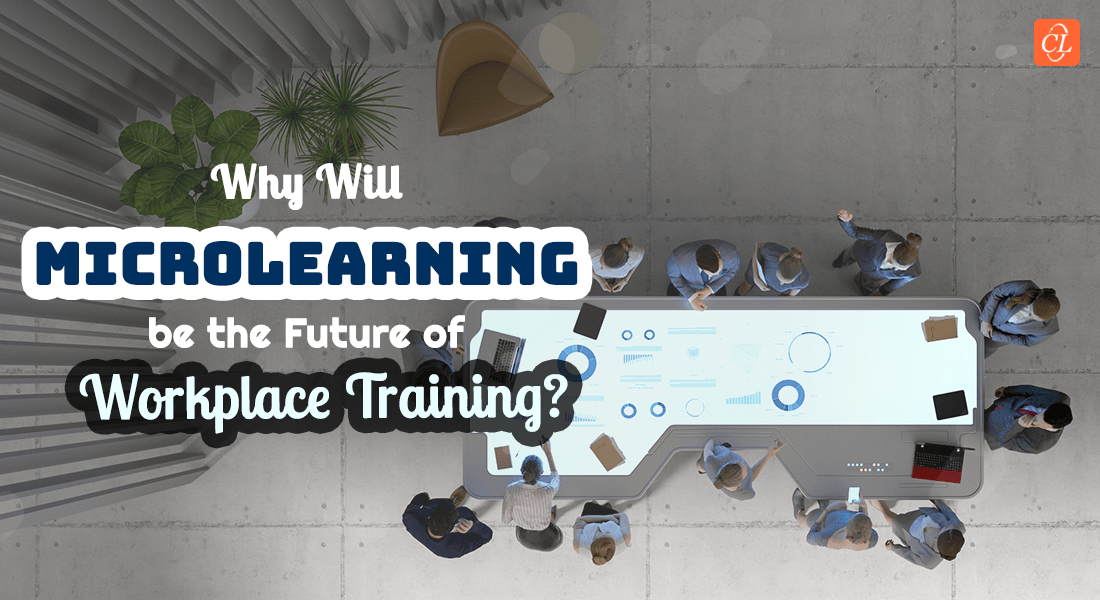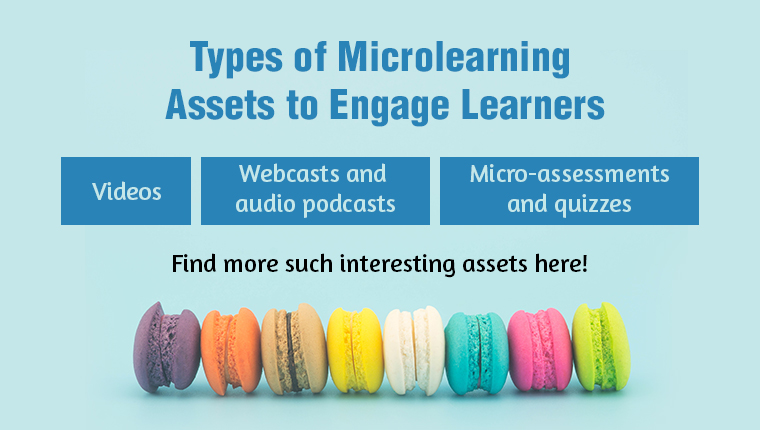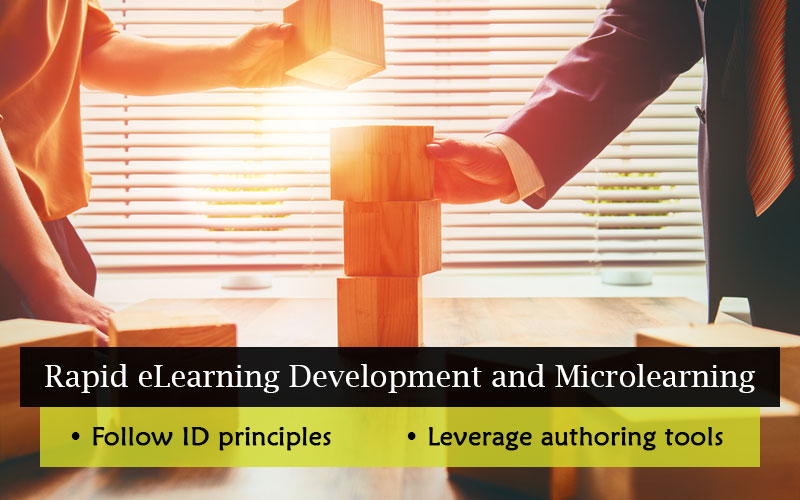Why is Microlearning the Future of Workplace Training?

Let’s admit it. Today’s fast-paced environment has created a slew of distractions for your learners such as crammed schedules, diminishing attention spans, never-ending to-do lists, and blurring lines between home and working. How do you go about training your staff in such situations? The answer lies in microlearning.
Microlearning is a versatile and efficient form of training that can be used to improve individual and organizational performance. It serves up bite-sized chunks of information, each addressing a single learning objective. Today, microlearning is on the rise to become a mainstay of the eLearning domain, and it is a strategic tool that is being implemented by businesses all around the world. Continue reading to discover more about microlearning and why it is the future of workplace training.
Why is Microlearning the Future of Workplace Training?
Microlearning is the Future of Workplace Training because it:
- Saves Time and Money
- Enhances Retention
- Appeals to a Multigenerational Workforce
- Facilitates Scalability
- Enables Mobile-Friendly Learning
- Appeals to Millennials
- Leverages Cutting-edge Strategies
Why is Microlearning the Future of Workplace Training?
1. Saves Time and Money
One of the leading learning architects of our time, Ray Jimenez(PhD), , asserts in his book 3-Minute eLearning that creating microlearning courses may help eLearning developers minimize their costs by 50% and increase the speed of production by 300%.
Creating microlearning courses can assist you in getting the most out of your training expenditure. By using existing content and templates and implementing standardization to create such micro modules you reduce the time and money spent. The whole process takes much more time when creating “conventional” eLearning courses.
The popular adage by Benjamin Franklin sums it up well, “time is money”.
Furthermore, the efficacy of bite-sized modules ensures that your staff receives the best possible training.
There are several effective tools available on the market to help you create microlearning content. Microlearning videos, for example, can be created with easy-to-use tools like Vyond and Videoscribe, while interactive PDFs and infographics can be created with tools like Adobe Illustrator and Adobe Photoshop. Using Microlearning for your training needs saves a lot of time because it is just so simple to use.
Getting started with microlearning? Explore the implementation roadmap!
2. Enhances Retention
More than half of newly learned knowledge is forgotten within a few days. The key to beating the forgetting curve is to refresh your learners’ knowledge on a regular basis. Researchers have shown that microlearning enhances retention. In an age when multitasking and productivity are revered, learners prefer training courses that build on their existing skills and that do not require them for long periods of time.
Microlearning can be used to provide follow-up or reinforcement exercises so that learners keep updating their knowledge and skills. Learning spanning the learners’ years at work, just-in-time learning, and memory retrieval are all features of these bite-sized courses. Microlearning makes it easier for learners to recall short and condensed pieces of information. Studies have shown that microlearning is more successful than traditional classroom instruction in terms of the transfer of information.
3. Appeals to a Multigenerational Workforce
L&D teams are facing the challenge of training employees from different generations. Developing training for the various types of needs in each generation is a challenge. Training should not only pique your learners’ interest, but it should also provide learning platforms that are best suited to them. To complicate matters further, an approach that appeals to one generation may be ineffective for another.
Despite significant differences, there are several things that all generations have in common. People want to learn and improve their performance at work. They want to receive constructive feedback from their managers and mentors as well as explore lifelong learning options.
There are no easy solutions, however one can employ a strategy that uses the flexibility that microlearning courses affords to train your multigenerational workforce.
4. Facilitates Scalability
Large scale training content usually takes a long time to develop and is much more difficult to generate than microlearning assets (tiny units of learning information). These micro assets require less time to create, record, curate, and update. Since microlearning assets are smaller files, they can be distributed internationally with ease, allowing the L&D teams to keep their learners on the same page that are spread out across the globe in various groups.
Furthermore, due to the minute size of each asset, you may be able to produce microlearning courses yourself. Whether you pool knowledge in from your internal resources, search the web, or find competent vendors you can save a lot of your SME’s time by doing your homework and making room for them to quickly add in their inputs. You can also rapidly adapt to your learners’ demands with micro assets that double up as just-in-time learning materials in order for them to keep up to date.
5. Enables Mobile-Friendly Learning
For millennials, mobile phones are an essential part of life. As a result, using mobile platforms to access courses increases active participation. Microlearning gives you the ability to create mobile-friendly modules. This allows you to create training programs that works with your learners’ schedules and does not require them to leave their desks.
The flexibility to get things done on the go using mobile phones has become a huge temptation to employees as we advance towards a digitally forward world. Moreover, practically every part of our lives has adjusted to the new way of working remotely on mobiles and laptops due to the pandemic.
Many employees regard job-related training as a stressful obligation and something that they must fit into their already hectic schedules. However, if they can train on their mobiles and at the same time work around other obligations, the number of individuals who complete their training is likely to grow.
6. Appeals to Millennials
Microlearning is a tool that is intended to meet the demands of today’s Millennial workforce. Employees can access their training modules at their own pace using mobile phones which provides them the freedom to take courses from any location using any mobile device. Microlearning equips learners with new skills and information through highly engaging content.
Microlearning enhances learning by personalizing courses and adding nuances based on the specific requirements of learners. Furthermore, Artificial Intelligence and Machine Learning has impacted training by making it more individualized, leaving classroom learning far behind.
A case in point: Google employs the Whisper app to send emails or ‘whispers’ to its managers that encourages them to act on their on-the-go learning vis-a-vis microlearning modules.
Microlearning courses are action-oriented harnessing the power of real-time application wherever possible. Microlearning modules come in a variety of forms, such as:
- Infographics
- Scenarios
- Videos
- Games
- Quizzes
Microlearning courses, unlike classroom training sessions, give instant feedback on quizzes and assessments, allowing its learners to remedy their errors. Microlearning ensures that younger employees gain new skills and knowledge from their training and that the company values their self-directed remedial efforts.
7. Leverages Cutting-edge Strategies
You can increase the efficacy of your L&D programs by implementing several microlearning assets. Microlearning allows you to take advantage of cutting-edge strategies such as gamification where learners are rewarded with points, and leaderboards track the learners total scores.
Artificial Intelligence is used to recommend next steps for employees microlearning courses based on employees’ topics of interest or the need to retake a course,
The combination of Virtual Reality and Microlearning allows employees to learn in any environment ranging from pristine labs to primitive factories. Core training activities can be carried out virtually while performance data is gathered to provide prompt feedback allowing employees to learn on the job. Microlearning is a powerful method of learning that’s changing the way global businesses train their personnel.
Parting Thoughts!
It is not surprising that Microlearning is trending in 2022 and has been the popular choice for corporate organizations. It makes use of today’s learners’ attention spans to provide training that is highly focused on a single learning objective. It entails studying bite-sized modules in quick succession to enhance learner engagement, improve comprehension, and strengthen retention.
If you want to learn more about the eLearning space, here’s a free eBook on eLearning trends in 2022. If you are a training manager or a member of the L&D community, this eBook will provide you with highlights of what is trending in corporate training in 2022!





